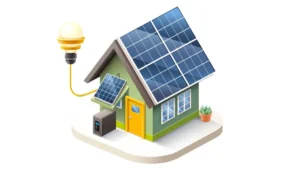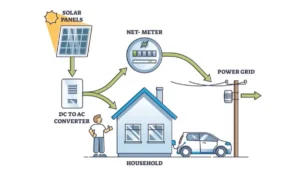HOME IMPROVEMENT
Hamro Solar LLC: Pioneering Sustainable Energy for a Greener Future

Hamro Solar LLC is a company that aims to eliminate the traditional ways of energy consumption by opting for solar power as the core solution. Being a solar company whose mission is to help people and businesses avoid leaving carbon footprints and become stewards of the world earth, Hamro Solar LLC offers unparalleled solar energy solutions that can help users generate their electricity and reduce expenses on centralized energy.
History and Background
It was established to provide solar energy all over the country and the company has rapidly expanded over the past few years. It was founded by a team of people, all of whom shared a similar passion for the increasing environmental changes that demanded change through the adoption of clean energy solutions. Hamro Solar Company has grown over the years to offer many services to its customers apart from only installing solar panels and improving its technology. These days it is recognized for its customer focus, quality, and efforts towards renewable energy sources.

Services Offered by Hamro Solar LLC
Hamro Solar LLC offers a comprehensive range of services designed to meet the unique energy needs of its clients. These services include:
Solar Panel Installation
Hamro Solar provides end-to-end solar panel installation services, from initial consultation and site assessment to design, installation, and maintenance. The company uses high-quality, efficient solar panels that maximize energy production and ensure long-term reliability.
Energy Management Solutions
Understanding that effective energy management is key to maximizing the benefits of solar power, Hamro Solar offers advanced energy management systems. These systems allow clients to monitor and optimize their energy consumption, reducing waste and enhancing the overall efficiency of their solar installations.
Energy Storage Systems
Hamro Solar LLC offers energy storage services which remains one of the best among the services offered by the company. Through battery storage technology, the clients can store the excess energy produced during the day for use at night or in case of bad weather. It also further boosts the grid reliability capacity and independence in addition to improving the grid efficiency.
Benefits of Energy Storage:
- Reliability: Battery storage systems ensure that there is a steady power supply, now and again, when the sun is not shining, or when the demand rises very high.
- Grid Independence: Through obtaining more storage spaces for energy, clients will be able to ration the amount of energy they need from the grid hence cutting expenses and additional costs of energy security.
- Efficiency: Energy storage when generation is high and using that stored energy when needed optimizes the use of the solar installations, improving the overall system efficiency.
Customized Solar Solutions
As for the methods, the Hamro Solar LLC company mainly focuses on the individual approach for each client and the subsequent adjustment of the offered solar solution. For the homeowner renovating a house or a business constructing a new building, the company’s specialists make proper studies and then implement energy-efficient systems that offer excellence in results and efficiency for the least amount of money invested.
Solar Energy Solutions for Homeowners
With regards to homeowners, for instance, the use of solar energy has several benefits for every person. Hamro Solar LLC mainly operates in residential solar that can be described to be cheap yet very effective at the same time. At the moment, instead of using normal sources of electricity, some people are using solar power through rooftop solar panels placed in strategic places to produce electricity for their homes hence in the process they spend a lot of money on electricity bills. Also, the electricity from solar is emissions-free meaning that the homeowners will be conserving the environment besides ensuring they do not rely on foreign energy.

Commercial and Industrial Solar Solutions
For business and industry clients, Hamro Solar LLC has utility-scale solar systems that can be used to provide power for entire complexes and factories among others. These solutions aim at satisfying the energy requirements of organizations, especially the ever-rising energy demands, help organizations to cut costs, and at the same time support sustainability measures.
Solar Panel Technology and Quality
Hamro Solar LLC is known for using solar panels, which are sourced from some of the best manufacturers globally, and are of high quality and incorporating the latest technology. The solar panels that are incorporated in installation services offered by Hamro Solar are reputable for high efficiency, relatively long durability, and fine performance under low light conditions. This way, solar clients get the most value from their PV investments regardless of where they are or the climate they are subjected to.
Features of Hamro Solar Panels:
- High Efficiency: Hamro Solar has come up with solar panels that are more efficient in the way they capture sunlight and the amount of electricity produced as compared to conventional solar panels.
- Durability: High quality and fully tested, the solar panels at Hamro Solar are designed for longevity and come through even extreme heat, rainfall, and snow.
- Warranty and Support: Every panel is backed by durable warranties for the panels and the installation work, and clients are guaranteed the best services.
Environmental Impact and Sustainability
Environmental conservation is another major consideration that fuels the operations of Hamro Solar LLC in its provision of sustainable solar solutions. Solar energy is an abundantly accessible and clean source of power that does not emit any pollution during its utilization, thus making it suitable for electricity production to minimize emissions. Clients thus have a chance to contribute to combating climate change and preserving the environment by choosing Hamro Solar.

Steps in the Installation Process:
- Consultation and Assessment: This is a meeting to establish the consumer’s energy requirements, develop a site survey profile, and find out the suitable solar solution to recommend.
- Design and Proposal: A solar system plan is developed and a formal quotation which includes a cost estimate, projected savings, and period of implementation is given to the client.
- Installation: Hamro Solar has certified technicians to carry out installation so that everything is done right and on time.
- Inspection and Activation: Inspection that takes place after installation checks on whether the system meets safety and performance requirements. As soon as the connection receives approval, a client can begin producing their solar energy.
- Ongoing Support: Maintenance and support services are offered by Hamro Solar hence can help you to maintain the system at the highest performance.
Warranties and Guarantees
Of the strategies that Hamro Solar LLC has adopted to differentiate itself in the industry, one that stands out is warranties and guarantees. Every system and product that has been installed has its standard warranty that covers the functionality of the equipment as well as the work done in the installation process. These elements of commitment to quality and customer satisfaction give the clients a sense of assurance regarding their investment with Hamro Solar and that the company fully supports its products.
-

 BIOGRAPHY6 months ago
BIOGRAPHY6 months agoBehind the Scenes with Sandra Orlow: An Exclusive Interview
-

 HOME1 year ago
HOME1 year agoDiscovering Insights: A Deep Dive into the //vital-mag.net blog
-

 HOME1 year ago
HOME1 year agoSifangds in Action: Real-Life Applications and Success Stories
-

 BIOGRAPHY1 year ago
BIOGRAPHY1 year agoThe Woman Behind the Comedian: Meet Andrew Santino Wife




























